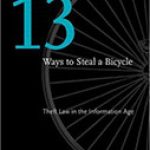Virtual Economies and Financial Crime: Money Laundering in Cyberspace
 Author: Clare Chambers-Jones
Author: Clare Chambers-Jones
Publisher: Cheltenham, UK; Northampton, VT: Edward Elgar Publishing, 2012. 256p.
Reviewer: Kim-Kwang Raymond Choo | September 2013
Criminals and organised crime groups exist and operate mainly for economic gain (although some traditional organised crime groups may also aim at exercising political power). To disguise the origins of the proceeds of crime, criminals can perform a series of business transactions prior to integrating the ‘cleaned’ proceeds into the legitimate financial system. They understand the many benefits in money laundering, which include the ability to enhance their lifestyle and to enable the profits of their crimes to be re-invested in future criminal activities or in legitimate business operations (Asia/Pacific Group on Money Laundering 2011; Choo 2008).
The money laundering process is typically segmented into three stages.
- Placement: In the placement stage the money launderer introduces illegal profits into the financial system. In some cases, illegally obtained funds may already lie within the financial system such as where funds have been fraudulently obtained or misappropriated electronically from the accounts of businesses. Placement can also entail splitting large amounts of cash into less conspicuous smaller sums that are then deposited directly into a bank account (an activity also known as structuring) and/or using new payment methods.
- Layering: After the funds have entered the financial system, the money launderer may engage in a series of transactions to distance the funds from their source. In this layering stage, the funds might be channelled through the purchase of investment instruments, or by transferring money electronically through a series of accounts at various banks and/or using mobile money transfer services. The money launderer might also seek to disguise the transfers as payments for goods or services, thus giving them a legitimate appearance. A money launderer can also recruit individuals or establish front companies to purchase electronic currency or cash under the reporting thresholds to avoid triggering identification or reporting requirements.
- Integration: Disguised funds (cleaned money) would appear to have been legally earned, and it is extremely difficult to discern between legal and illegal wealth at this stage.
The financial sector is often seen as the gatekeeper of the Anti-Money Laundering/Counter Terrorism Financing (AML/CFT) regime. In recent years, new payment methods (e.g. virtual currencies) are increasingly being seen as a widely accepted payment method and have been highlighted as potential money laundering and terrorism financing instruments (AUSTRAC 2012; Choo 2013; International Association of Financial Crimes Investigators 2013; Irwin, Slay, Choo and Liu 2013a). For example, money laundering and exploitation of information and communications technologies (ICT), including new payment methods, were assessed by the Australian Crime Commission as two of four key enablers in organised criminal activities in that country (Australian Crime Commission 2011). Although the potential for virtual currencies to be exploited for money laundering and terrorism financing has been on the agenda for some time, it is an under researched area especially compared to its real-world counterpart (Irwin, Choo and Liu 2012).
“Virtual economies and financial crime: Money laundering in cyberspace” by Associate Professor of Law Clare Chambers-Jones (2012) is certainly a timely addition to the literature. The book seeks to place the virtual world and currencies, and financial crime and money laundering in a broader historical and social perspective – see Chapters 2 to 5, as well as in a legal perspective – see Chapters 4 to 6.
Chapters 2 and 3 would have benefited from a broader focus on virtual worlds / economies rather than Second Life, as Second Life is only one of many virtual worlds. In addition, Chapter 2 is relatively brief, and perhaps it should have been merged with Chapter 3 to form a chapter on “Virtual worlds and virtual economies.” Another issue in these two chapters is definitional. Although there is an attempt to explain what is a virtual world (in Chapter 3), a more lasting and useful contribution would have been a panoramic analysis of existing definitions for virtual worlds and virtual economies (to offer the most inclusive definition of the terminologies that has been proposed or published), and a typology of the virtual worlds, virtual economies and crime.
Chapter 4 explains the evolution of money and UK banking and financial regulations. Given the emphasis on UK legislation in this chapter, this should perhaps be reflected in the chapter heading (e.g. A UK perspective)?
Chapter 5 provides a good overview of the threat, trends and challenges associated with virtual worlds and virtual economies using several relevant real-world cases. This chapter reinforces the view that existing patterns of the understanding of virtual money laundering and virtual financial crime require reconceptualisation when criminals exploit the resources of virtual worlds and virtual economies and the interstices between national or provincial regulatory boundaries.
Chapter 6 is the highlight of the book, and perhaps the most forward-looking chapter that is a welcome inclusion in the book. This chapter examines the (in)effectiveness of existing legislation on virtual money laundering and virtual financial crime, and raises various questions that require further research and in-depth examination. A comparison of the AML/CTF regulatory regimes in the context of virtual money laundering and virtual financial crime would have been beneficial to the reader (for example, see Walters, Budd, Smith, Choo, McCusker and Rees 2012).
Overall, this book fulfils its objective of providing the reader with an introduction to the virtual world and currencies, and financial crime and money laundering. The book would be an interesting read to those who are new to the topic. However, the sub-title “Money laundering in cyberspace” can be misleading, as it does not go into any depth on how virtual / cyber money laundering and terrorism financing can be conducted, detected or prevented.
References
Asia/Pacific Group on Money Laundering 2011. APG yearly typologies report 2011: Methods and trends of money laundering and terrorism financing. Sydney South, NSW, Australia: APG Secretariat [http://www.austrac.gov.au/files/apg_typologies_report_2011.pdf; last accessed 1 July 2013] Australian Crime Commission 2011. Organised crime in Australia. Canberra, ACT: Australian Crime Commission
Australian Transaction Reports and Analysis Centre (AUSTRAC) 2012. AUSTRAC typologies and case studies report 2012. Canberra, ACT: Australian Transaction Reports and Analysis Centre [http://www.austrac.gov.au/files/typ_rprt12_full.pdf; last accessed 1 July 2013]
Choo KKR 2008. Organised crime groups in cyberspace: a typology. Trends in Organized Crime 11(3): 270 – 295
Choo KKR 2013. New payment methods: A review of 2010-2012 FATF mutual evaluation reports. Computers & Security 36(2013): 12–26
International Association of Financial Crimes Investigators 2013. Virtual currency: Overview and emerging risks. El Dorado Hills, CA: International Association of Financial Crimes Investigators [http://www.htcia.org/wp-content/uploads/VirtualCurrencyWhitePaperFINAL32013.pdf; last accessed 1 July 2013]
Irwin ASM, Choo KKR and Liu L 2012. An analysis of money laundering and terrorism financing typologies. Journal of Money Laundering Control 15(1): 85–111
Irwin ASM, Slay J, Choo KKR and Liu L 2013a. Are the financial transactions conducted inside virtual environments truly anonymous?: An experimental research from an Australian perspective. Journal of Money Laundering Control 16(1): 6–40
Irwin ASM, Slay J, Choo K-K R and Liu L 2013b. Money laundering and terrorism financing in virtual environments: A feasibility study. Journal of Money Laundering Control [In press]
Walters J, Budd C, Smith RG, Choo KKR, McCusker R & Rees D 2012. Anti-money laundering and counter-terrorism financing across the globe: A comparative study of regulatory action. Research and public policy No 113, Canberra: Australian Institute of Criminology.
[http://www.aic.gov.au/documents/4/E/E/%7b4EE0EECA-9079-45DB-80A1-743CFCE5D58E%7drpp113.pdf; last accessed 1 July 2013]
Kim-Kwang Raymond Choo, Senior Lecturer, University of South Australia.


